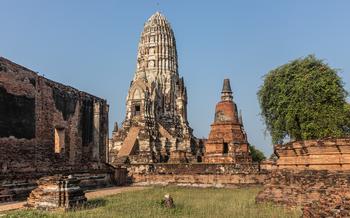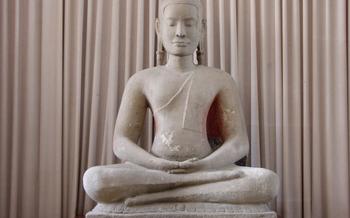
Wat Phra Ngam
- Historical significance
- Exploring the Ruins of Wat Phra Ngam
- Unveiling the Legends of Wat Phra Ngam
- Stepping into the Past: The History of Wat Phra Ngam
- Admiring the Architectural Splendor of Wat Phra Ngam
- Exploring the Surrounding Area of Wat Phra Ngam
- Capturing the Essence of Wat Phra Ngam Through Photography
- Insider Tip: Unveiling the Hidden Gems of Wat Phra Ngam
Historical significance
Wat Phra Ngam, situated in the heart of Lopburi, holds immense historical significance as a testament to the grandeur of the ancient Ayutthaya Kingdom. Built between the 14th and 15th centuries, the temple stands as a symbol of the kingdom's architectural prowess and religious fervor. Its well-preserved ruins captivate visitors with their intricate carvings, majestic prang, and serene atmosphere, offering a glimpse into the glorious past of Thailand.
Architectural features
The architectural style of Wat Phra Ngam is a harmonious blend of Khmer and Thai influences, showcasing the cultural exchange and artistic fusion that characterized the Ayutthaya period. The temple's most striking feature is its central prang, a towering spire that rises majestically above the surrounding ruins. Intricate carvings adorn the prang's surface, depicting mythical creatures, celestial beings, and scenes from Buddhist mythology. These intricate details provide valuable insights into the artistic traditions and religious beliefs of the era.
Religious importance
Wat Phra Ngam was not only a place of worship but also a center of religious learning and pilgrimage during the Ayutthaya Kingdom. It was dedicated to the Buddha, and its sacred grounds were believed to possess a powerful spiritual energy. The temple's central prang housed a revered Buddha image that attracted devotees from far and wide, who came to pay homage and seek blessings. Even today, Wat Phra Ngam remains an important pilgrimage site for Buddhists in Thailand, who visit to pay their respects and experience the temple's serene spiritual atmosphere.
Practical information
Wat Phra Ngam is easily accessible, located just a short distance from the city center of Lopburi. It is open to visitors daily from 8:00 AM to 5:00 PM, and admission is free of charge. When visiting the temple, it is essential to dress respectfully and observe local customs. Visitors are advised to wear long pants or skirts and avoid revealing clothing. Photography is permitted, but it is essential to be mindful of the sacred nature of the site and to avoid causing any disturbance to worshippers.
Exploring the Ruins of Wat Phra Ngam
Amidst the remnants of Wat Phra Ngam, visitors can embark on a journey of discovery. The temple's central feature is the majestic prang, a towering Khmer-style structure that dominates the skyline. Its intricate carvings depict scenes from Buddhist mythology, revealing the artisans' exceptional skill and devotion.
Beneath the prang, visitors can find a treasure trove of Buddha images, each exuding a unique aura of serenity and spirituality. Some statues are colossal, while others are smaller and more delicate, reflecting the diversity and richness of the Buddhist tradition.
The ancient stupas, with their graceful curves and intricate designs, stand as testaments to the temple's long history. These structures, once used to enshrine relics and sacred objects, evoke a sense of awe and reverence. As visitors explore the ruins of Wat Phra Ngam, they are transported back in time to an era of architectural grandeur and spiritual devotion.
Unveiling the Legends of Wat Phra Ngam
Legends and folklore are intertwined with the history of Wat Phra Ngam, adding a mystical aura to the temple ruins. One of the most well-known tales is the legend of the monkey king, Hanuman. According to the Ramayana epic, Hanuman, the loyal companion of Lord Rama, is said to have taken a break at Wat Phra Ngam during his epic journey to Lanka to rescue Sita. Impressed by the temple's beauty, he left his footprints on one of the temple's walls, which can still be seen today.
Another captivating legend surrounds the reclining Buddha image enshrined within the temple. It is believed that a monk once meditated before the reclining Buddha and fell into a trance for many years. When he awoke, he possessed profound knowledge and wisdom, becoming renowned as a revered teacher and healer. The reclining Buddha image is thus revered by locals and pilgrims alike, who seek blessings and guidance from this sacred figure.
Beyond these legends, Wat Phra Ngam is also associated with various myths and folklore that have been passed down through generations. Locals believe that the temple is inhabited by spirits and deities who protect and guide those who visit. These beliefs add a sense of mystery and enchantment to the temple, making it a place where the past, the present, and the supernatural converge.
Stepping into the Past: The History of Wat Phra Ngam
Wat Phra Ngam's history is deeply intertwined with the rise and fall of the Ayutthaya Kingdom, one of the most significant eras in Thai history. The temple's origins can be traced back to the 14th century when it was constructed under the reign of King U Thong, the founder of the Ayutthaya dynasty. Initially built as a Khmer-style temple, it showcased intricate carvings and bas-reliefs depicting scenes from Hindu mythology.
Over the centuries, Wat Phra Ngam underwent several renovations and restorations, reflecting the changing artistic and architectural influences that swept across the kingdom. During the reign of King Narai the Great in the 17th century, significant additions were made to the temple, including the construction of the impressive prang, or central tower. The prang, adorned with delicate stucco work and vibrant colors, became a defining feature of Wat Phra Ngam and a testament to the grandeur of the Ayutthaya period.
Despite the destruction that befell Ayutthaya in the 18th century, Wat Phra Ngam remarkably survived, albeit in a dilapidated state. The temple's resilience and historical significance led to its restoration in the 19th century under the patronage of King Rama IV. This restoration aimed to preserve the temple's unique architectural features while incorporating elements of the then-prevalent Rattanakosin style.
Today, Wat Phra Ngam stands as a testament to the enduring legacy of the Ayutthaya Kingdom. Its ruins, although weathered and worn, continue to captivate visitors with their intricate details and historical charm, offering a glimpse into Thailand's rich past.
Admiring the Architectural Splendor of Wat Phra Ngam
Wat Phaya Kingdom, seamlessly blending Khmer and Thai influences to create a unique and captivating style. The temple's most striking feature is its magnificent prang, a towering spire adorned with intricate carvings and bas-reliefs depicting scenes from Buddhist mythology and Thai history. The prang is complemented by a series of smaller stupas, each adorned with unique decorative elements and symbolizing different aspects of the Buddhist faith.
Beyond the prang, the temple's walls are adorned with exquisite carvings and bas-reliefs, depicting a myriad of figures, from mythical creatures to historical figures. These carvings provide a glimpse into the beliefs, values, and artistic sensibilities of the Ayutthaya period. The temple's doorways and windows are also adorned with intricate designs, creating a sense of harmony and balance that is characteristic of Thai architecture.
Exploring the Surrounding Area of Wat Phra Ngam
Beyond the temple grounds, Wat Phra Ngam is situated amidst a vibrant and culturally rich neighborhood. Just a short stroll away, visitors can immerse themselves in the bustling atmosphere of local markets, where they can sample delicious street food, browse handmade crafts, and engage with friendly vendors.
In the vicinity of the temple, history buffs will delight in exploring the ancient ruins of Phra Prang Sam Yod, a trio of majestic prangs that offer a glimpse into the architectural heritage of the Ayutthaya Kingdom. The surrounding area also boasts several charming cafes and restaurants, providing an opportunity to relax and savor local delicacies while soaking in the temple's serene ambiance.
For those seeking a deeper cultural immersion, venturing into the neighboring communities offers a chance to interact with the local people, learn about their customs and traditions, and gain insights into their way of life. By supporting local businesses and participating in cultural events, visitors can contribute to the preservation of the region's rich heritage while creating meaningful connections with the community.
Capturing the Essence of Wat Phra Ngam Through Photography
Wat Phra Ngam presents a treasure trove of photographic opportunities for enthusiasts seeking to capture the temple's captivating allure. To maximize your photography experience, consider these tips:
-
Embrace the Golden Hour: The warm, diffused light of the early morning or late afternoon hours can create stunning photographs. Plan your visit accordingly to take advantage of this magical time.
-
Experiment with Different Perspectives: Don't limit yourself to standard shots. Try capturing the temple from unique angles, such as from the base looking up or from a higher vantage point.
-
Focus on Details: The intricate carvings, bas-reliefs, and decorative elements of Wat Phra Ngam are a photographer's delight. Zoom in to capture the exquisite craftsmanship and symbolism that adorn the temple.
-
Utilize Natural Light: Avoid using flash photography, as it can create harsh shadows and distort the temple's natural colors. Instead, rely on natural light to illuminate your subjects.
-
Respect the Sacred Space: Remember that Wat Phra Ngam is an active Buddhist temple. Be mindful of religious ceremonies and rituals, and avoid disturbing worshippers during their devotions.
Insider Tip: Unveiling the Hidden Gems of Wat Phra Ngam
Beyond the main attractions, Wat Phra Ngam holds hidden gems that reveal its rich history and intricate details. Venture into the lesser-known areas of the temple, such as the back chambers, to discover unique artifacts and hidden details that often go unnoticed. These chambers may house ancient scriptures, Buddha images, or remnants of past renovations. Engaging with locals can also lead to fascinating insights into the temple's secrets. Ask them about local legends, stories, or hidden spots that may not be commonly known. They may guide you to a secluded corner, a forgotten inscription, or a unique perspective of the temple that will enhance your understanding and appreciation of this ancient site.


